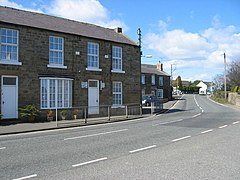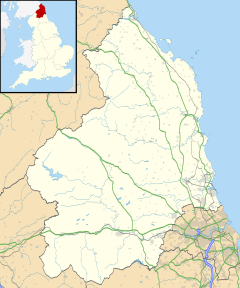|
Longhorsley
Longhorsley is a village in Northumberland, England about 7 miles (11 km) northwest of Morpeth, and about 14 miles (23 km) south of Alnwick. The A697 road passes through the village linking it with Morpeth, Wooler and Coldstream in Scotland.[1] There are 8 "Streets" in Longhorsley: Whitegates, Church View, Drummonds Close, South Road, West Road, East Road and Reivers Gate, Wilding Place and (Davison Court within Wilding Place).The village is bordered on the north by the River Coquet. The village formerly lay in three separate townships: Bigges Quarter, Freeholders Quarter and Riddells Quarter.[1] Local amenities at present include: St Helen's First School; Millar's Shop; Albion House Hairdressing; and The Shoulder of Mutton Pub. The population of Longhorsley Parish is approximately 800, measured at the 2011 Census as 887,[2] and is essentially a residential community for those who work in South Northumberland and Tyneside.[1] GovernanceLonghorsley is in the electoral ward of Chevington with Longhorsley. This ward covers both East Chevington and Longhorsley plus their surrounding areas. The total population of this ward at the 2011 Census was 5,596.[3]
LandmarksThe Devil's Causeway passes the village less than 2 miles (3 km) to the west. The causeway is a Roman road which starts at Portgate on Hadrian's Wall, north of Corbridge, and extends 55 miles (89 km) northwards across Northumberland to the mouth of the River Tweed at Berwick-upon-Tweed. A hoard of Roman coins discovered by metal-detecting enthusiasts on a farm near Longhorsley, Northumberland, could be evidence that entrepreneurial native Northumbrian settlers were recycling old bronze coins and making trinkets to sell back to soldiers in the Roman army, according to experts. The hoard of 70 Roman coins – 61 sestercii and 9 dupondii — dates from the reign of Emperor Vespasian to the reign of Emperor Marcus Aurelius (AD69–180). For part of this period, during the reign of Antoninus Pius, the Antonine Wall, built between Glasgow and Edinburgh, and not Hadrian's Wall, marked the northern frontier of the Roman Empire in Britain, and for a short period, Northumberland, which had until then been barbarian territory, became part of the Roman Empire. The hoard was found close to the route of the Devil's Causeway, the main Roman road which ran north through Northumberland. Roman expert Lindsay Allason-Jones, Director of Archaeological Museums at Newcastle University, where the coins were put on display, said: "What makes this find unusual is that it dates from a period when there was no Roman fort close to Longhorsley, although there were a number of native settlement sites in the area".[4][1][5] 
Religious sitesExterior and interior of St Thomas of Canterbury The Anglican Church of St. Helen, which has registers dating from 1688.[1] The Roman Catholic church, St Thomas of Canterbury, which was erected in 1841. Before the Catholic church was built, the parish was served from the pele tower which stands adjacent to the present church.[1]
Notable people
References
External linksWikimedia Commons has media related to Longhorsley. |
||||||||||||||||||||||||||||||||||||
Portal di Ensiklopedia Dunia



